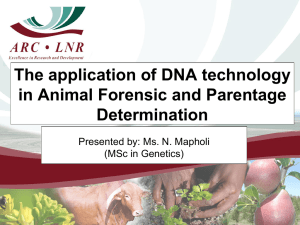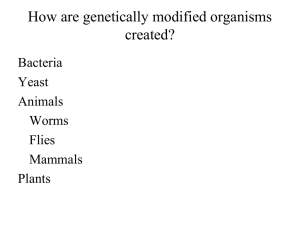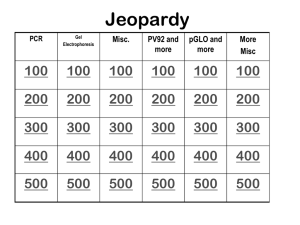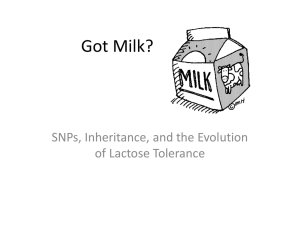POLYMERASE CHAIN REACTION (PCR)
advertisement
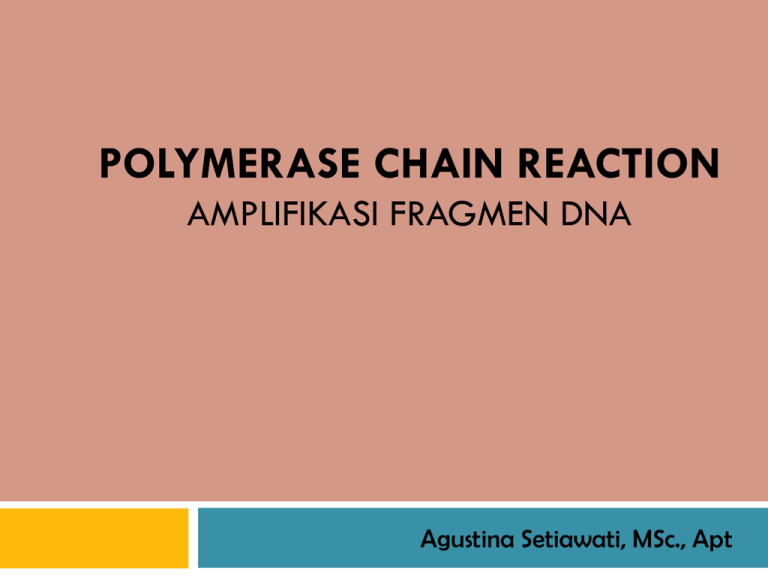
POLYMERASE CHAIN REACTION AMPLIFIKASI FRAGMEN DNA Agustina Setiawati, MSc., Apt Background on the Polymerase Chain Reaction (PCR) Ability to generate identical high copy number DNAs made possible in the 1970s by recombinant DNA technology (i.e., cloning). Cloning DNA is time consuming and expensive (>>$15/sample). Probing libraries can be like hunting for a needle in a haystack. PCR, “discovered” in 1983 by Kary Mullis, enables the amplification (or duplication) of millions of copies of any DNA sequence with known flanking sequences. Requires only simple, inexpensive ingredients and a couple hours. DNA template Primers (anneal to flanking sequences) DNA polymerase dNTPs Mg2+ Buffer Can be performed by hand or in a machine called a thermal cycler. 1993: Nobel Prize for Chemistry The polymerase chain reaction (PCR) can selectively and rapidly amplify a given DNA sequence to large amounts Used in cloning, sequencing, forensics, diagnosis Specific primers hybridize on each side of the DNA sequence to be copied Enzyme – Taq DNA polymerase – from Thermus aquaticus – resistant to high temperatures Very sensitive – can amplify a sequence present in very low copy number How PCR works: 1. Begins with DNA containing a sequence to be amplified and a pair of synthetic oligonucleotide primers that flank the sequence. 2. Next, denature the DNA at 94˚C. 3. Rapidly cool the DNA (37-65˚C) and anneal primers to complementary s.s. sequences flanking the target DNA. 4. Extend primers at 72˚C using a heat-resistant DNA polymerase (e.g., Taq polymerase derived from Thermus aquaticus). 5. Repeat the cycle of denaturing, annealing, and extension 20-45 times to produce 1 million (220)to 35 trillion copies (245) of the target DNA. 6. Extend the primers at 72˚C once more to allow incomplete extension products in the reaction mixture to extend completely. 7. Cool to 4˚C and store or use amplified PCR product for analysis. Example thermal cycler protocol used in lab: Step 1 7 min at 94˚C Initial Denature Step 2 45 cycles of: 20 sec at 94˚C 20 sec at 64˚C 1 min at 72˚C Denature Anneal Extension Step 3 7 min at 72˚C Final Extension Step 4 Infinite hold at 4˚C Storage BIOL 362 samples processed in: MJ Research DNA Engine Dyad Hot water bacteria: Thermus aquaticus Taq DNA polymerase Life at High Temperatures by Thomas D. Brock Biotechnology in Yellowstone © 1994 Yellowstone Association for Natural Science http://www.bact.wisc.edu/Bact303/b27 Fig. 7.23 Denature Anneal PCR Primers Extend PCR Primers w/Taq Repeat… 10_27_1_PCR_amplify.jpg The polymerase chain reaction – used to amplify a specific DNA sequence with cyclical changes in temperature 10_27_2_PCR_amplify.jpg PCR – applications: 1) The method of choice for cloning relatively short DNA sequences (under 10,000 nts) – can use to get genomic clone or cDNA clone 10_28_PCR_clones.jpg PCR – applications: 1) The method of choice for cloning relatively short DNA sequences (under 10,000 nts) – can use to get genomic clone or cDNA clone 2) Can detect infectious pathogens at very early stages 3) PCR is used in forensic medicine to generate a DNA fingerprint – based on amplifying areas of the genome that contain VNTRs (variable number tandem repeats) 10_29_PCR_viral.jpg Using PCR to detect a viral genome in a drop of blood 10_30_1_PCR_forensic.jpg Primers are used to amplify areas with VNTRs, which differ in different chromosomes, different individuals 10_30_2_PCR_forensic.jpg Three areas amplified to generate a DNA fingerprint Basic idea…lets say we want to amplify 1 gene of 500 bp from some bacterial DNA. DNA * must know the sequence at the limits/ends of the * design complementary primers anneal to template 5 3 5 3 3 5 3 5 Melt template, then rapidly cool * some primers will anneal to complementary sequence 5 3 3 5 5 3 3 5 Melt template, then rapidly cool * some primers will anneal to complementary sequence 5 3 3 5 Add DNA polymerase * provide substrate + time to extend 5 3 3 5 Melt template, then rapidly cool * some primers will anneal to complementary sequence 5 3 3 5 Add DNA polymerase * provide sunstrate + time to extend These 3 steps constitute 1PCR ‘cycle’, which will be repeated many times (usually 25-30) 1) melt template 2) anneal oligonucleotide primers 3) extend with DNA polymerase If ever confused about how PCR works… * draw out first three cycles 25-30x Limitations – finite amounts of * dNTPs * primers * DNA pols Exhaustion after 30 PCR AKUMULASI EKSPONENSIAL FRAGMEN TERAMPLIFIKASI Setelah 30 siklus 2 pangkat 28 = 268 345 456 fragmen Good Primer’s Characteristic A melting temperature (Tm) in the range of 52 C to 65 C Absence of dimerization capability Absence of significant hairpin formation (>3 bp) Lack of secondary priming sites Low specific binding at the 3' end (ie. lower GC content to avoid mispriming) Uniqueness There shall be one and only one target site in the template DNA where the primer binds, which means the primer sequence shall be unique in the template DNA. There shall be no annealing site in possible contaminant sources, such as human, rat, mouse, etc. (BLAST search against corresponding genome) Template DNA 5’...TCAACTTAGCATGATCGGGTA...GTAGCAGTTGACTGTACAACTCAGCAA...3’ CAGTCAACTGCTAC TGCTAAGTTG 5’-TGCTAAGTTG-3’ Primer candidate 2 5’-CAGTCAACTGCTAC-3’ A TGCT AGTTG Primer candidate 1 NOT UNIQUE! UNIQUE! Length Primer length has effects on uniqueness and melting/annealing temperature. Roughly speaking, the longer the primer, the more chance that it’s unique; the longer the primer, the higher melting/annealing temperature. Generally speaking, the length of primer has to be at least 15 bases to ensure uniqueness. Usually, we pick primers of 17-28 bases long. This range varies based on if you can find unique primers with appropriate annealing temperature within this range. PANJANG PRIMER Panjang primer 8 4 pangkat 8 = 65.536 pb Ukuran kromosom 3.000.000 kb ada 46.000 kemungkinan situs Panjang primer 17 = 17.179.869.184 pb diharapkan hanya menempel pada 1 situs Base Composition Base composition affects hybridization specificity and melting/annealing temperature. • Random base composition is preferred. We shall avoid long (A+T) and (G+C) rich region if possible. Template DNA 5’...TCAACTTAGCATGATCGGGCA...AAGATGCACGGGCCTGTACACAA...3’ TGCCCGATCATGCT • Usually, average (G+C) content around 50-60% will give us the right melting/annealing temperature for ordinary PCR reactions, and will give appropriate hybridization stability. However, melting/annealing temperature and hybridization stability are affected by other factors. Therefore, (G+C) content is allowed to change. Melting Temperature Melting Temperature, Tm – the temperature at which half the DNA strands are single stranded and half are double-stranded.. Tm is characteristics of the DNA composition; Higher G+C content DNA has a higher Tm due to more H bonds. Calculation Shorter than 13: Tm= (wA+xT) * 2 + (yG+zC) * 4 Longer than 13: Tm= 64.9 +41*(yG+zC-16.4) /(wA+xT+yG+zC) (Formulae are from http://www.basic.northwestern.edu/biotools/oligocalc.html) Annealing Temperature Annealing Temperature, Tanneal – the temperature at which primers anneal to the template DNA. It can be calculated from Tm . Tanneal = Tm_primer – 4C Primer Pair Matching Primers work in pairs – forward primer and reverse primer. Since they are used in the same PCR reaction, it shall be ensured that the PCR condition is suitable for both of them. One critical feature is their annealing temperatures, which shall be compatible with each other. The maximum difference allowed is 3 C. The closer their Tanneal are, the better. Summary ~ when is a “primer” a primer? 5’ 3’ 5’ 3’ 5’ 3’ 3’ 5’ Summary ~ Primer Design Criteria 1. Uniqueness: ensure correct priming site; 2. Length: 17-28 bases.This range varies; 3. Base composition: average (G+C) content around 50-60%; avoid long (A+T) and (G+C) rich region if possible; 4. Optimize base pairing: it’s critical that the stability at 5’ end be high and the stability at 3’ end be relatively low to minimize false priming. 5. Melting Tm between 55-80 C are preferred; 6. Assure that primers at a set have annealing Tm within 2 – 3 C of each other. 7. Minimize internal secondary structure: hairpins and dimmers shall be avoided. Macam PCR PCR spesial RFLP-PCR Reverse Transcriptase-PCR (RT-PCR) Nested-PCR Real Time-PCR (RT-PCR) RT-PCR Procedure mRNA was isolated from a tissue cell culture Reverse transcriptase used to synthesize cDNA from mRNA PCR performed on cDNA using Taq polymerase and primers specific for Syk gene Beta-actin used as an external control for the RTPCR Southern blot used a biotynlated internal Syk probe used to confirm amplification of Syk mRNA RT-PCR Results Syk is expressed in normal mammary gland tissue and breast epithelial cells Several carcinoma cell lines expressed Syk strongly Some carcinoma cell lines poorly expressed Syk Some carcinoma cell lines completely lack Syk expression Advantages Disadvantages RT-PCR is much faster and more sensitive that RNase protection assays RT-PCR is very sensitive and can detect low levels of mRNA in cells RT-PCR requires a lot of preparation and must be strictly controlled Non-competitive RT-PCR may result in false conclusions because experimental results are caused by differences in PCR conditions REAL TIME PCR RT PCR Apakah Real-Time PCR ? ‘Real Time’ dapat dikatakan sebagai mengoleksi dan menganalisa data yang terjadi selama proses reaksi ‘Real Time PCR’ berarti amplifikasi dan analisa terjadi bersamaan Dikenal sebagai ‘Rapid Cycle PCR’ dengan siklus temperatur antara 2060 detik Produk PCR dapat dianalisa selama proses amplifikasi Menggunakan ‘pewarna DNA’ dan ‘probe fluoresensi’ Data dikoleksi dari tabung yang sama didalam instrumen yang sama Tidak ada transfer sampel, penambahan reagensia atau gel separasi Apakah Real-Time PCR ? Format deteksi : SYBR Green I Hybridization Probes (HybProbe Probes) Hydrolysis probes / Taqman Probes SimpleProbe Probes Dapat melakukan ‘real-time quantitative PCR’ ‘Real Time PCR’ adalah metode yang ‘powerful’, sederhana dan cepat Applications For Detecting and Quantifying Transcripts Quantifying viruses Pathogen detection Gene expression Drug therapy DNA damage Immune response Genotyping Monitoring PCR Reaction Agarose Gel Blotting LightCycler What’s Wrong With Agarose Gels? Poor precision. Low sensitivity. Short dynamic range < 2 logs. Low resolution. Non-automated. Size-based discrimination only. Results are not expressed as numbers. Ethidium bromide staining is not very quantitative. Approaches in quantifying by PCR . 3. Real-time RT-PCR (QPCR). Measurement .occurs during exponential phase. Available Chemistries for detecting PCR product (amplicon). 1. Intercalating dyes that fluoresce, e.g. SYBR Green I. 2. Hybridization probes, Scorpions. Molecular Beacons. Donor probe excites acceptor by FRET. 3. Hydrolysis probes, Quench is by nonradiative transfer: Taqman system. 4. Simple probes 1. SYBR Green I Ketika SYBR Green I berikatan dengan dsDNA, akan terjadi peningkatan fluoresensi Selama tahapan PCR yang berbeda, intensitas dari sinyal fluoresensi akan berbeda, tergantung dari jumlah dsDNA yang ada SYBR Green I Fluoresces when bound to dsDNA 2. HybProbe Probes Hybridization probe merubah fluoresensi pada saat hibridisasi dengan ‘fluorescene resonance energy transfer (FRET)’ Fluorescence Resonance Energy Transfer (FRET) E E E E FRET is Nonradiative energy transfer Energy Transfer R >> R o A No Transfer A D R D 3. Taqman probes are “hydrolysis” probes Polymerization 5’ Forward Primer TaqMan® R Probe Q 3’ 5’ 5’ 3’ 5’ Reverse Primer Displacement 5’ Forward Primer R Q 3’ 5’ 5’ 3’ 5’ Reverse Primer Hydrolysis R Q 5’ 3’ 5’ 5’ 3’ 5’ Polymerization Completed R Q 5’ 3’ 5’ 5’ 3’ 5’ 4. Simple Probes Simple Probe adalah bentuk sederhana dari hybridization probe dan hanya menggunakan 1 probe saja Ketika terjadi hibridisasi akan memancarkan sinyal fluoresensi yang lebih besar Perubahan sinyal fluoresensi tergantung dari status hibridasi dari probe, semakin stabil hibridisasinya semakin tinggi temperatur melting Untuk aplikasi SNP genotyping dan deteksi mutasi Molecular Beacons are “hybridization” probes Masalah PCR Hasil PCR tidak ada atau sedikit Terlalu banyak pita Pita-pita tidak jelas Suhu hibridisasi primer Hasil PCR sedikit atau tidak ada Turunkan suhu hibridisas Muncul terlalu banyak pita Naikan suhu hibridisasi Masalah preparasi DNA Larutan DNA berwarna (kontaminasi) Tidak ada DNA Rasio A260/A280 rendah (gula, fenol, protein) TERIMA KASIH





